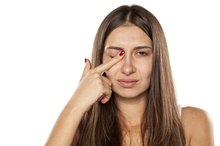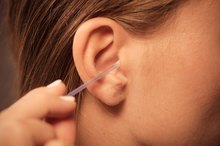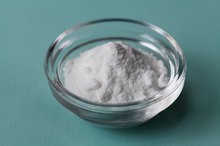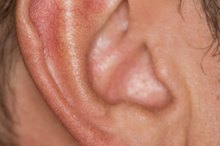What Causes Itchy Ears?
Many of the same skin diseases that occur in other areas of the body can also affect the ears. Infection, dermatitis and psoriasis can cause problems with the skin of the outer ear and ear canal, provoking itching. Ear canal itching can be particularly maddening and potentially dangerous, as the desire to relieve the itching may lead to accidental injury of the eardrum.
If you are experiencing serious medical symptoms, seek emergency treatment immediately.
Eczema
Eczema is a general term referring to irritation of the skin associated with intense itchiness. Chemical irritants, such as hair products or soaps, can cause eczema of the ears. In other cases, the ear rash is caused by an allergic reaction. In some people -- especially children -- an eczematoid rash is part of a long-term skin condition called atopic dermatitis. Avoidance of any triggering substances is helpful in many cases. Topical medication may be needed to treat atopic dermatitis of the ears.
- Eczema is a general term referring to irritation of the skin associated with intense itchiness.
Seborrheic Dermatitis
Itchiness Behind the Ears
Learn More
Seborrheic dermatitis is a chronic inflammatory skin condition characterized by an itchy, waxy, scaling rash. The ears are commonly affected in adults with the disorder. Seborrheic dermatitis is caused by an inflammatory immune response to Malassezia yeast, which normally inhabits the skin. The yeast produces substances that trigger a skin reaction in people with seborrheic dermatitis. Antifungal medications and topical steroids typically prove useful in controlling seborrheic dermatitis.
- Seborrheic dermatitis is a chronic inflammatory skin condition characterized by an itchy, waxy, scaling rash.
- Seborrheic dermatitis is caused by an inflammatory immune response to Malassezia yeast, which normally inhabits the skin.
Psoriasis
Psoriasis is a lifelong skin condition characterized by patchy, dry areas of skin overgrowth capped by silvery-white scales. Itching and pain commonly occur in involved areas. Psoriasis can affect any skin surface, including the outer ear and ear canal. Psoriasis scale buildup in the ear canal can cause blockage. Removal of the blockage and topical medications are typically used to control psoriasis scales involving the ear.
- Psoriasis is a lifelong skin condition characterized by patchy, dry areas of skin overgrowth capped by silvery-white scales.
- Psoriasis scale buildup in the ear canal can cause blockage.
Swimmer's Ear
Itchy Eyelash Follicles
Learn More
Swimmer’s ear, also known as otitis externa, occurs when the skin of the ear canal becomes inflamed or infected. An abnormal amount of moisture in the ear increases the likelihood of developing this condition. The most common symptoms of otitis externa are itching and pain of the ear canal. Swelling may cause temporary hearing loss due to partial blockage of the canal. The affected ear often requires cleaning by an ear doctor to remove drainage and skin debris. Eardrops clear the infection and reduce skin irritation.
- Swimmer’s ear, also known as otitis externa, occurs when the skin of the ear canal becomes inflamed or infected.
- The most common symptoms of otitis externa are itching and pain of the ear canal.
Earwax Problems
Earwax, or cerumen, protects the skin of the ear canal 2. It keeps the canal clean and resists bacterial infection. Cerumen normally moves outward to the opening of the ear canal, where it flakes off the skin surface. Overzealous efforts to keep the ears clean by removing cerumen with cotton-tipped swabs can lead to dryness and itching of the ear canal. Ear itching associated with inadequate cerumen typically clears with discontinuation of the use of cotton swabs to clean the ear canal. Cerumen impaction -- an overabundance of earwax that blocks the ear canal -- can also cause ear itching.
- Earwax, or cerumen, protects the skin of the ear canal 2.
- Cerumen impaction -- an overabundance of earwax that blocks the ear canal -- can also cause ear itching.
Related Articles
References
- Ear Disease: A Clinical Guide; Michael Hawke
- A Pocket Guide to the Ear; Albert L. Menner
- Treatment of Psoriasis; Jeffrey M. Weinberg
- American Family Physician: Diagnosis and Management of Cerumen Impaction
- Memar, Omeed & Caughlin, Benjamin & Djalilian, Hamid. (2019). Psoriatic Involvement of the Ear. The Hearing Journal. 72. 44.doi:10.1097/01.HJ.0000552754.82111.04.
- Amor-dorado JC, Barreira-fernandez MP, Pina T, Vázquez-rodríguez TR, Llorca J, González-gay MA. Investigations into audiovestibular manifestations in patients with psoriatic arthritis. J Rheumatol. 2014;41(10):2018-26. doi:10.3899/jrheum.140559
- Joly-tonetti N, Wibawa JID, Bell M, Tobin DJ. An explanation for the mysterious distribution of melanin in human skin: a rare example of asymmetric (melanin) organelle distribution during mitosis of basal layer progenitor keratinocytes. Br J Dermatol. 2018;179(5):1115-1126. doi:10.1111/bjd.16926
- Amor-dorado JC, Barreira-fernandez MP, Pina T, Vázquez-rodríguez TR, Llorca J, González-gay MA. Investigations into audiovestibular manifestations in patients with psoriatic arthritis. J Rheumatol. 2014;41(10):2018-26. doi:10.3899/jrheum.140559
- Kim WB, Jerome D, Yeung J. Diagnosis and management of psoriasis. Can Fam Physician. 2017;63(4):278-285.
- National Institute on Deafness and Other Communication Disorders. Why You Shouldn’t Use Cotton Swabs to Clean Your Ears. Updated July 17, 2017.
- National Psoriasis Foundation. Psoriasis on the Face. Updated June 25, 2019.
- Merck Manual Professional Version. Psoriasis. Revised November 2018.
- American Academy of Dermatology Association. ARE TRIGGERS CAUSING YOUR PSORIASIS FLARE-UPS?
- National Psoriasis Foundation. Managing Itch. Updated July 12, 2019.
- Amor-Dorado, J.; Barreira-Fernandez, M.; Pina, T. et al. Investigations into audiovestibular manifestations in patients with psoriatic arthritis. J Rheumatol. 2014 Oct;41(10):2018-26. doi:10.3899/jrheum.140559
- Memar, O.; Caughlin, B.; and Djalilian, H. Psoriatic Involvement of the Ear. Hearing J. 2019 Jan;72(1);44-7. doi:10.1097/01.HJ.0000552754.82111.04
Writer Bio
Dr. St. John is a medical writer and editor with more than 15 years experience in the field. She is a former medical officer for the Centers for Disease Control and Prevention.









